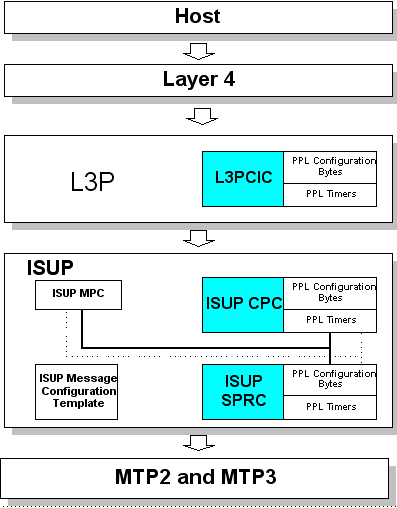
You are here: CSP Developerís Guide: Common Channel Signaling†>†4 SS7 Call Control for ISUP †>†ISUP Outgoing Call Setup

Overview
This section includes call flow examples for ISUP outgoing call control.
Outgoing SS7 Call Setup Diagram
This diagram illustrates the interaction between the host and the SS7 PPL components in the handling of an outgoing SS7 call. Shading identifies the software components involved in the call.

The table below describes the default outgoing call sequence.
|
Stage |
Description |
|---|---|
|
1 |
An outgoing call is initiated by the host to the Outseize Control message. The CSP will accept address data as either BCD-encoded digits or in an SS7 Parameters ICB. The Outseize Control message drives L4 into an outseize state and an outseize request is sent to L3P. |
|
2 |
L3P CIC translates the L4/L5 event into an ISUP event. Any parameters sent from L4/L5 are concatenated with pre-stored parameter data in the PPL Configuration Bytes. |
|
3 |
The parameters and events are sent to the appropriate ISUP Component. If parameter validation is successful, the parameters are formatted into a raw SS7 message and sent to ISUP SPRC. If validation fails, a PPL Event Indication message of Protocol Violation is sent to the host. |
|
4 |
ISUP SPRC routes the message to MTP for transmission. |
The call flows in this section include more details about the numbered messages. The numbered messages are described following each call flow.
Any mandatory SS7 parameters not supplied by the host in an Outseize Control message are retrieved from the L3P CIC PPL Configuration Bytes.

1. An Outseize Control message ACK does not report to the host until a backward signal is received from the network.
2. The PPL Event Indication message to the host indicates the backward signal type (ACM, ANM, CPG, or CON) and an SS7 Parameters ICB with parameter data. If the host application does not require parameter data, the CSP acknowledges and ignores the PPL Event Indication message.
Outgoing Call Rejection by Network
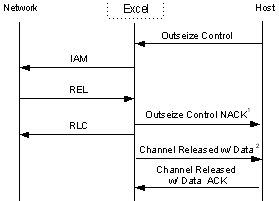
1. The host receives a Negative Acknowledgment (NACK) to the Outseize Control message.
2. The Channel Released With Data message contains an SS7 Parameters ICB with the REL parameter data.
BLO Received in Response to IAM
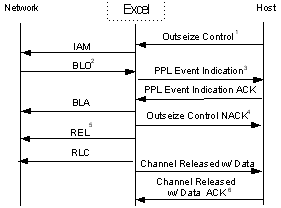
1. The Outseize Control message generates an outgoing IAM to the network.
2. The CSP receives BLO in response to IAM.
3. The CSP generates a PPL Event Indication message to the host, indicating receipt of BLO. The CSP automatically generates BLA to the network.
4. The CSP generates an Outseize Control message NACK to the host.
5. The CSP automatically generates REL to the network.
6. Upon receipt of the RLC from the network, the CSP generates Channel Released with Data message to the host.
UCIC Received in Response to IAM (ANSI only)
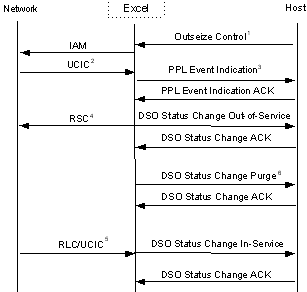
1. Outseize Control message generates outgoing IAM to the network.
2. UCIC is received in response to the IAM.
3. PPL Event Indication is generated to the host indicating UCIC.
4. RSC is generated and purge is initiated by the CSP.
5. Upon receipt of RLC or UCIC from the network, DS0 status of In-Service is reported to the host.
*Generation of RSC in this call flow is the default behavior. However, PPL Configuration Byte (0x2A) in L3P CIC can suppress this message. The RLC/UCIC response to the RSC would not be received. The CSP-to-host messages will be the same regardless of the configuration byte value.
RSC Received in Response to IAM
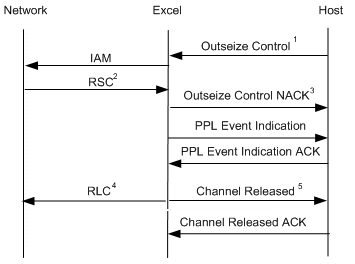
1. Outseize Control message generates IAM to the network.
2. RSC is received in response to IAM.
3. Outseize Control message ACK is generated to the host with response status of Outseize Failure No Acknowledgment (0x1B).
4. RLC is generated automatically to the network.
5. A Channel Released with Data message is sent, notifying the host that the channel is now idle.
No Acknowledgment of IAM (Expiration of T7)
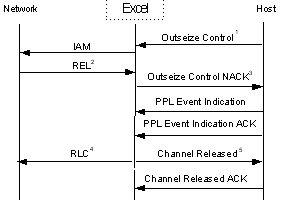
1. The Outseize Control message generates an IAM to the network.
2. T7 expires. REL is generated automatically to the network.
3. An Outseize Control ACK is reported to the host with response status 0x1B (Outseize Failure No Acknowledge).
4. Upon receipt of RLC, a Channel Released with Data message is reported to the host.
No Acknowledgment of IAM or REL (Expiration of T7)
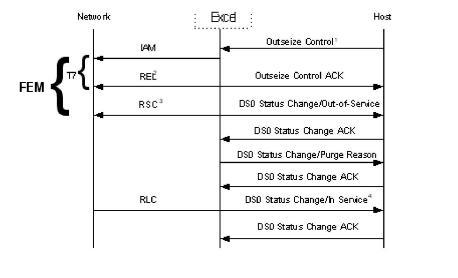
1. The Outseize Control message generates outgoing IAM to the network. Front End Machine FEM Outseize ACK Timer is initiated (29 seconds). T7 is initiated upon sending of the IAM.
2. T7 expires. REL is automatically generated to the network and Outseize Control ACK is reported to the host with a response of 0x1B (Outseize Failure No Acknowledgment).
3. FEM Outseize ACK Timer expires and initiates a channel purge. An RSC is generated to the network.
4. Upon receipt of the RLC, A DS0 Status Change indicating
In-Service is reported to the host.
An SS7 network-initiated REL may occur at any time during call setup. The call flow is the same regardless of when the REL is received.
.
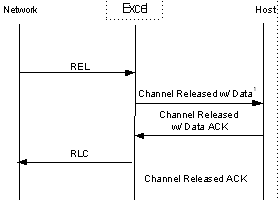
1. Parameters in the REL are sent to the host in the Channel Released With Data message.
2. The Channel Released With Data message must be acknowledged by the host, after which the channel is in an idle state and can be used for further call processing.
Host-Initiated Release

1. The host may provide parameters for the REL message in the Release With Data message.
2. The Channel Released with Data message must be acknowledged by the host within 5 seconds or the CSP resends the message.

1. The Channel Released message must be acknowledged by the host within 5 seconds or the CSP resends the message.
2. If the Distant End Release Mode for the VRU and the Local End Release Mode of the SS7 channel is set to Release, the SS7 channel is not automatically released. The CSP sends a Channel Release Request, indicating that it intends to release the channel. If either mode is set to park, the SS7 channel parks and a DS0 Status Change message informs the host.